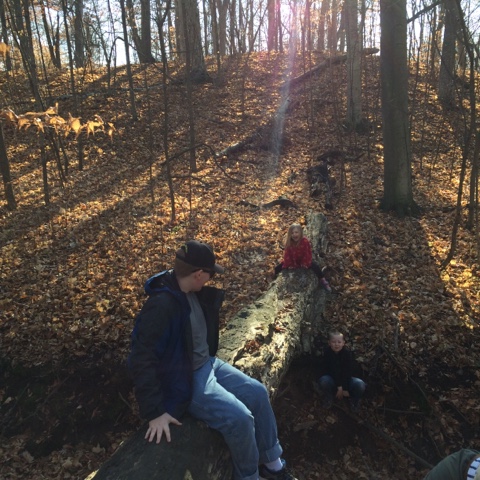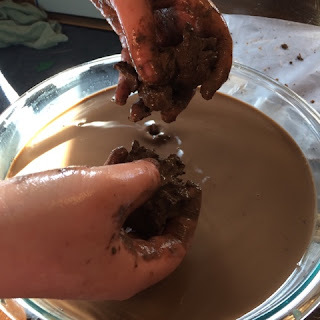First of all, we found the stream that I thought that I remembered -- and it being fall, it's done like a number of the small water ways around here, and it's mostly dried up. Which was perfect: we could climb right into the stream bed, and with a little care the kids stayed out of the water (I threatened that if they got soaked we'd immediately go home) and had a good time checking out the stream's banks. We saw where water had undercut, and followed the stream bed a little, just fooling around exploring. It's amazing how often fantastic things happen when we look like we're just playing outside: the trick is to learn to be observant and to ask good questions while you play. (John Muir Laws is great for learning good observation and question skills.) The importance of play is easy to overlook, but it's during play that you see the serendipitous discoveries that happen as the kids explore the environment.
And that's how it happened this time. First, I asked Hero a few questions to help him see the way that water works on our land, and find connections between his reading and the real world, so that we could learn to see in new ways, the way that our book is teaching. The book is suggesting the possibility of a type of intense learning through careful observation that I'd never thought was possible, and I'm really loving the way that it's starting to shape our thinking. So I asked a few questions to get encourage the connection between our environment and the book. It took maybe 5 minutes. Then, I stepped back and they started playing. They found a log that had fallen across the stream, bridging the gap, which was a lot of fun.
I didn't take pictures of the digging process (I wish I had, but I didn't realize anything important was happening, at the time), but Dragon got down under that log, and started banging and digging away at the bank, while my friend Mrs. T. and I chatted and played with her baby, and the other kids did other things -- and pretty soon both boys were digging, because they'd found this amazing clay -- it felt more than a little bit like play-doh, straight out of the ground. They brought over some for the baby to play with; she wasn't having anything to do with it at first, but Hero was persistent and she did eventually check it out. Which meant that the moms got to check it out, too. I didn't get a picture of the clay balls that I told the kids they could bring home, but I did think to get a shot of Dragon's feet. He was impressively muddy; this kid is an all-in type of kid!
Happily, a lot of that came off as we walked over to the playground and back. So it's not all on my kitchen floor, needing to be swept up!
So, this morning, we got it out and started playing with it. The kids wanted to make something from it. I knew just enough to know that it probably needed to be cleaned up somehow, to make it more usable. Hurray for Google, right? I found instructions pretty easily: dissolve the clay in water, and pour it off.
The clay floats, forming a solution with the water, and the dirt sinks. So you can pour off the good stuff, and dump the parts that aren't usable.
Once we got into the process, I was feeling a little unsure about how to go about getting the clay back out of the water, so I turned to YouTube to see if I could find an example of what it looks like when it's done, and I'm glad I did: turns out that, you can do a lot of pouring in this process. You pour the clay-water off pretty quickly, and that leaves behind your sediment. We had a lot more sand that I'd been expecting.
Then, you let it sit some more and the water starts to separate back out, and you can pour that off too. It starts pretty quickly: this picture was taken after maybe 10 or 15 minutes, and you can already see the clear water layer forming on top.
After it had sat for a few minutes -- I think it was maybe half hour, but it could have been a little more -- there was quite the layer of mostly clear water. Pouring it off turned out to be a little tricky, so I left it to sit a while longer and tried a scoop the second time.
We had two containers, and the larger one looks like it's going to take just a little bit longer. It's interesting to see the variation between the smaller batch and the larger. The ball of clay in the big bowl was considerably larger than what went into the mason jar, and so the solution was a fair amount thicker, and it seems like it's taking a little longer to separate. Or it could be that the water is spread out over the larger surface. I don't really know. But I think that getting the water off this one will be a bigger challenge.
We spent a while, pouring, waiting, scooping, and pouring again, trying to get as much water out as possible, while losing as little clay as possible. It's pretty tricky: if you disturb the clay layer, it sends up clouds of clay particles into the water layer. And it's really easy to disturb it. I think that the clay particles must be pretty lightweight. But after a while, we'd made some progress, and I started thinking about what I wanted to sacrifice to be a filter for these. They need to stay separate, because Hero had a larger lump, and had done nearly all the work with his, and the little kids had combined theirs and had a lot more help with the process, agreeing that whatever clay comes out at the end, they will split evenly. So it's problematic to just put the two containers together and work with a single lump, although that would simplify things.
I wish I knew how well this stuff is going to wash out of the clothes and fabric we use.
I need to check if we're freezing tonight... I wonder how that would affect things.
The kids want to get some more clay, and have been debating if they think it would be best to go back soon, in spite of the cold, or wait until spring, and risk the water being in the way. I've never paid enough attention to the stream to have any idea how full it gets in the spring and summer. We'll have to wait and see on that one. I am not super excited about digging in the cold, myself, and the filtration process is going to be tough the more we get below freezing, which should happen any time here. Whenever it is we go, I'm loving the way that they're learning to think things through and plan how to do what they want to accomplish.
I also started to study how to get the clay to a point where it's usable, and figure out how to go about making it into a thing. Nobody's really decided what they want to build yet, but before we can make a project, we need to have workable clay. Looking at this tutorial for using local clays, it looks like it may be worth our while to call the local pottery shop and see if they can help us out at all with firing our projects. I don't think that the oven is going to be enough. But the site does have a procedure for getting the clay ready to work. This process is going to take a while, I'm thinking. Lots of evaporation that needs to happen.
I wish I knew how well this stuff is going to wash out of the clothes and fabric we use.
I need to check if we're freezing tonight... I wonder how that would affect things.
The kids want to get some more clay, and have been debating if they think it would be best to go back soon, in spite of the cold, or wait until spring, and risk the water being in the way. I've never paid enough attention to the stream to have any idea how full it gets in the spring and summer. We'll have to wait and see on that one. I am not super excited about digging in the cold, myself, and the filtration process is going to be tough the more we get below freezing, which should happen any time here. Whenever it is we go, I'm loving the way that they're learning to think things through and plan how to do what they want to accomplish.
I also started to study how to get the clay to a point where it's usable, and figure out how to go about making it into a thing. Nobody's really decided what they want to build yet, but before we can make a project, we need to have workable clay. Looking at this tutorial for using local clays, it looks like it may be worth our while to call the local pottery shop and see if they can help us out at all with firing our projects. I don't think that the oven is going to be enough. But the site does have a procedure for getting the clay ready to work. This process is going to take a while, I'm thinking. Lots of evaporation that needs to happen.
Which is what the guy said when I called the local pottery shop: get it wet and remove the impurities, then work on drying it out. And the drying process isn't quick. Unfortunately, it doesn't sound like we're going to be able to have it fired at the pottery shops, so whatever we do will still be just messing around. Or maybe we'll learn from the survivalist websites how to fire things in the backyard. I don't know. But we've had a good time learning about this process. It's pretty interesting to see what we can do with fancy dirt that the kids dug up while they were playing!












1 comment:
Awesome! I'm excited to see where this exploration goes :)
Post a Comment